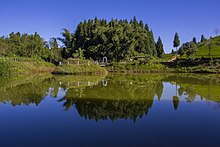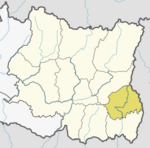|
Ilam District
Ilam district (Nepali: इलाम जिल्लाⓘ) is one of 14 districts of Koshi Province of eastern Nepal. It is a Hill district and covers 1,703 km2 (658 sq mi). The 2011 census counted 290,254 inhabitants.[1] The municipality of Ilam is the district headquarters and is about 600 km (370 mi) from Kathmandu. Ilam attracts many researchers and scientists for the study of medicinal and aromatic plants, orchids, rare birds and the red panda. Ilam stretches from the Terai belt to the upper hilly belt of this Himalayan nation. Etymology The name Ilam is derived from the Limbu language in which "IL" means twisted and "Lam" means road. Ilam was one of the ten self ruling states of Limbuwan before the reunification of Nepal. Its ruler, King Hangshu Phuba Lingdom of Lingdom dynasty, ruled Ilam as a confederate state of Limbuwan until 1813 AD. The treaty between the other Limbuwan states and the King of Gorkha (Gorkha-Limbuwan Treaty of 1774 AD), and the conflict of Gorkha and Sikkim, led to the unification of Ilam with Gorkha. Ilam was the last of the ten kingdoms of Limbuwan to be reunified into Nepal. The King of Gorkha gave the ruler of Ilam full autonomy to rule and the right of Kipat. Ilam was an independent Limbu kingdom until 1714 AD. Development and cultureIlam is today one of the developing places in Nepal, even though the Western parts are still struggling with the basic facilities (road networks, drinking water, health, etc.). The migration rate is very low, compared to other districts, due to the adoption of farming by individual families. Ilam Tea, a very famous leaf tea, is one of the finest quality teas in the world and is exported to Europe, Australia and the USA. The main source of income in this district is commercial agriculture, especially cash crops like tea, cardamom, ginger, potato, broom grass (Thysanolaena latifolia) production on a large scale and dairy and dairy related products like milk (Olan), cheese, Chhurpi (Traditional hard cheese) and lollipops (local sweets). Ilam is also considered to be an educational hub, where students from Ilam, Panchthar, Taplejung and Jhapa are plentiful. There are several institutions that offer secondary, higher secondary and university level programs. For a decade, there has been growing number of technical and vocational programs at secondary and university levels. Mahendra Ratna Multiple Campus, the oldest institution in Ilam, is one of the constituent campuses of Tribhuvan University. The first autonomous campus of Nepal, it is well known for its programs such as Agricultural Science, Education, Humanities and Commerce. The campus launched a Bachelor of Science program in Horticulture in 2012 (B.S. 2069), which has attracted students from all over the Nepal. Ilam is well known for its religious importance too. The Devi temples have a great importance attached to them and many people come here just for pilgrimage. The major attraction of Ilam is the nine-cornered Mai Pokhari lake. Also known as the Abode of the Goddess, many tourists as well as Nepalese people come to visit this place. This place is also one of the most famous places for flora and fauna, which attracts biologists. Similarly, Gajurmukhi is also a religious spot for pilgrimages from Nepal and India. The Mai river and its four tributaries also emerge in the Ilam district. Sano Pathivara is another place that is famous for pilgrimage. The famous Mane Bhanjyang (Mane pass) connects Ilam with the Darjeeling district of West Bengal, India. You must visit Fikkal and Kanyam.  Ilam was in the news a great deal during the Maoist insurgency, as it was from there that Maoists launched frequent, massive attacks. Geography and climate
Demographics
At the time of the 2021 Nepal census, Ilam District had a population of 279,534. Ilam has a literacy rate of 83.4% and a sex ratio of 1005 females per 1000 males. 166,513 (59.60%) lived in municipalities.[4] Ethnicity/caste: 20.79% were Rai, 16.10% Limbu, 13.90% Chhetri, 12.72% Bahun, 7.06% Tamang, 5.21% Magar, 3.76% Newar, 3.50% Kami and 3.04% Gurung. The Janjati communities are in majority here.[5] Religion: 44.19% were Hindu, 36.20% Kirat, 15.96% Buddhist and 3.51% Christian.[7] Nepali was the majority language in Ilam in 2021, spoken by 54.29% of the population as their first language. Other languages were Limbu (13.71%), Bantawa (7.53%), Rai (4.81%), Tamang (4.58%), Magar Dhut (3.56%), Chamling (1.25%), Newari and Gurung (1.00%). Other languages spoken here include Lepcha, which was the aboriginal language of neighbouring Sikkim and the Darjeeling Hills in India.[8] In 2011, Nepali was spoken by 42.8% of the population as their first language.[9] It seems that in Ilam, as in much of eastern Nepal, the Janjatis are abandoning their own languages in favour of Nepali. DivisionsIlam is divided into 4 urban and 6 rural municipalities.
Former Village Development Committees and Municipalities
Notable peopleIlam district is home to notable personalities including sportspersons and politicians.
See alsoReferences
External linksWikimedia Commons has media related to Ilam District.
|
|||||||||||||||||||||||||||||||||||||||||||||||||||||||||||||||||||||||||||||||||||||||||||||||||||||||||||||||||||||||||||||||||||||||||||||||||||||||||||||||||||||||||||||||
Portal di Ensiklopedia Dunia



